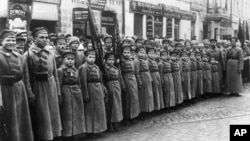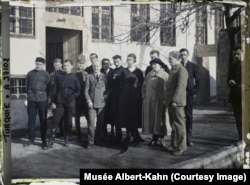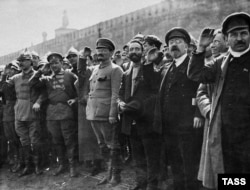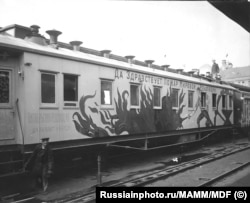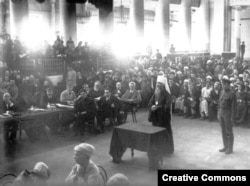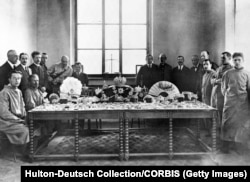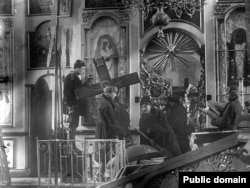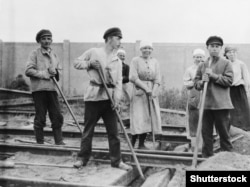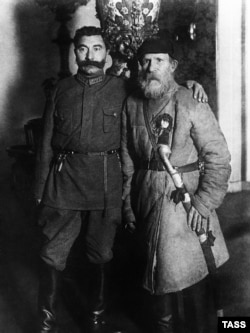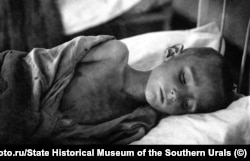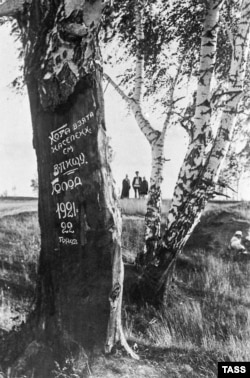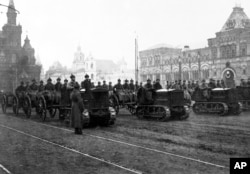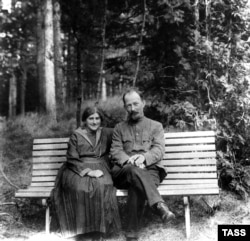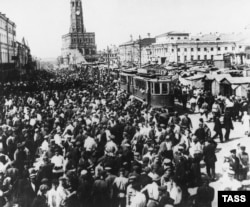Photos capture life on the ground and in the corridors of power as the Soviet Union was formed, amid turmoil and hunger, a century ago.
The above photo shows staff of the first Soviet Embassy in Ankara, Turkey, on December 30, 1922, the day the fledgling Soviet Union of Russian, Ukrainian, Belarusian, and "Transcaucasian" Socialist republics was officially declared.
The archival images in this gallery show ordinary Russians and leftist elites during the months Vladimir Lenin and his Socialist revolutionaries set the world on a dramatically new course as the Soviet Union took shape.
Revolutionary leaders photographed during a parade on Red Square in May 1922, including Mikhail Lashevich (second from left, saluting), Leon Trotsky (center left with moustache), Lev Kamenev (white collar, second from right), and Mikhail Tomsky (far right). All four of the men would later either be killed or commit suicide after clashing with Josef Stalin.
A train carriage that formed part of a "mobile agitation and propaganda apparatus" that traveled throughout Russia carrying lecturers and artists who promoted the ideas of the Bolshevik government during the country's civil war. The text on the train carriage declares, "Long live the fire of the world revolution" and "The October revolution gave power to the people."
Benjamin of Petrograd, a senior church leader who resisted the Bolshevik confiscation of church property, on trial for "counter-revolutionary agitation." He was executed in July 1922, a few weeks after this photo was taken.
Soviet officials display the captured crown jewels of the Russian royal family at an unspecified location in September 1922. The tsar, tsarina, and their five children had been shot and bayonetted to death by leftist revolutionaries four years earlier.
A religious ceremony held on Moscow's Red Square in September 1922. The gathering would prove to be one of the last mass displays of faith in Soviet Moscow as Lenin's staunchly atheist revolutionaries launched a war on Orthodox Christian "popes" and religion in general.
Church property is shown being confiscated at an unspecified location in winter 1922.
Workers on a railway line in spring or autumn 1922. Under Lenin, radical policies of gender equality were rolled out, leading to women joining the workforce en masse and abortion being made legal in 1920.
Red Army commander Semyon Budyonny (left) poses with a villager called Fyodor Gulyayev in the Kremlin in June 1922. Gulyaev was awarded a medal for luring hundreds of White Army horsemen into a swamp, where most of the bogged riders were killed, during the Russian Civil War.
A starving child in Russia’s Chelyabinsk region during a 1921-1922 famine in Russia in which at least 1 million people died. The famine was caused by a storm of factors including the economic chaos that followed the 1917 revolutions and the Bolsheviks' "war communism" that included what Lenin called "the confiscation of surplus from the peasants."
A photo from an album about the 1921-1922 famine that was rediscovered in 1989. The photo is inscribed with text saying that "people stripped the tree bark to eat" during the famine.
Red Army soldiers wearing spiked felt "budyonovka" caps parade on tractors across Moscow’s Red Square in November 1922.
A young couple inside an aircraft at an airfield in today's St. Petersburg in 1923.
Feliks Dzerzhinsky with his wife, Sofia, in the countryside near Moscow in 1923. The ethnic Pole was born into a noble family but became a fanatical Socialist and quickly rose through the ranks of Russia's revolutionaries to head the Bolshevik, then Soviet, secret police forces. "Iron Feliks" ordered mass killings of those he called "enemies of the revolution" often based solely on what he called their "class affiliation or their pre-revolutionary roles."
A tram moves through crowds at the Sukharevsky Market in Moscow in 1923. The exact date is unspecified.
A children's regiment of the Soviet Red Army in Moscow in December 1923.
Soon after this photo was taken, a constitution for the U.S.S.R. was ratified, and the United Kingdom joined several other countries in establishing formal ties with the Soviet Union.
